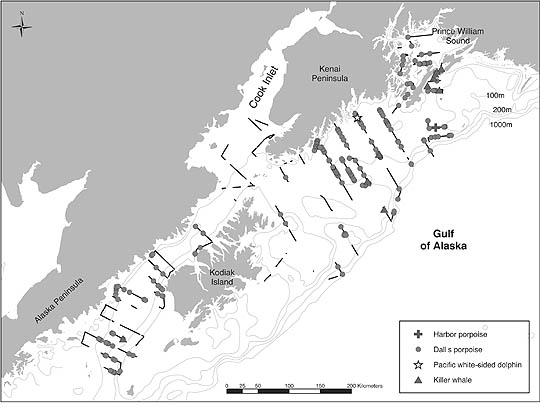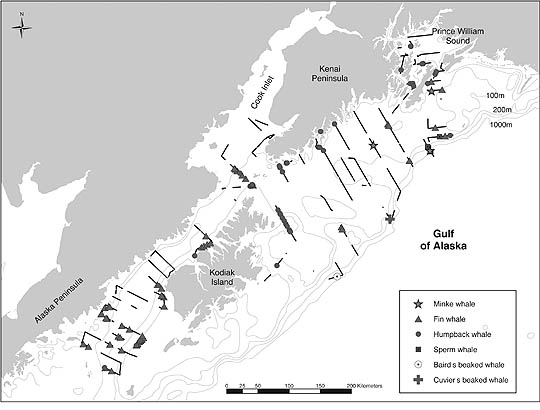|
CETACEAN ASSESSMENT AND ECOLOGY PROGRAM:
Cetacean Survey

Figure 1. Completed trackline and small cetacean sightings.
Three marine mammal observers participated on a cetacean survey from 26
June to 15 July 2003, aboard the NOAA ship Miller Freeman as a piggyback
project during a RACE acoustic-trawl survey for pollock (see RACE’s Midwater
Assessment and Conservation Engineering report in this issue). The primary
objective was to document the distribution of cetacean species occurring
on the shelf of the Gulf of Alaska and to collect line-transect data for
abundance estimation of cetacean species. The second objective was to
collect photo-identification and biopsy samples from selected species,
if time allowed.
The pollock acoustic survey runs tracklines from near shore to the shelf
break providing an ideal survey opportunity for a line-transect cetacean
survey. Surveys to determine distribution and abundance of cetaceans
are costly and therefore often confined to coastal waters where the logistics
are most practical or to areas of the ocean where marine mammal mortality
associated with commercial fishing is particularly high. The pelagic waters
of the Gulf of Alaska have not met either of those criteria and so are
comparatively under-sampled for cetaceans. The opportunity to use the
Miller Freeman as a survey platform is, therefore, extremely valuable.
Limitations to surveying from the Miller Freeman during the pollock survey
include room for only three marine mammal observers, which limits the number
of hours in a day that can be effectively surveyed, and limited time to
stop for photo-identification and biopsy sampling.
The Miller Freeman is a 215-ft long research vessel, and the survey was
conducted at an approximate speed of 11 kt. The survey included the west
side of Kodiak Island, Shelikof Strait, southern Cook Inlet, shelf waters
east of Kodiak Island and south of the Kenai Peninsula, and Prince William
Sound (Fig. 1 above). The cetacean survey was conducted from the flying bridge
at an eye height of approximately 12 m. Two observers searched through
25x150 power binoculars at starboard and port stations. A data recorder
searched the trackline with the naked eye, using Fujinon 7x50 hand-held
binoculars to confirm sightings. The observers rotated positions every
half hour during a 2-hour shift, followed by a half hour break. The survey
was suspended for meals, fishing operations, inclement weather, and when
light levels were too low for efficient observations.

Figure 2. Completed trackline and whale sightings.
A total of 2,242 km of trackline were surveyed with 364 cetacean sightings
(1,079 individuals). An additional 28 cetacean sightings were made (175
individuals) during off effort periods. Species included harbor porpoise,
Dall’s porpoise, Pacific white-sided dolphins, killer whales, minke whales,
fin whales, humpback whales, sperm whales, Baird’s beaked whales, and Cuvier’s
beaked whales (Table 1, Figs. 1 and 2).
|
Table 1. Number of cetacean sightings and individuals observed during the 2003 Miller Freeman survey. |
| |
Sightings |
Individuals |
Average |
| Species |
On effort |
Off effort |
On effort |
Off effort |
group size |
|
Harbor porpoise |
1 |
0 |
2 |
0 |
2.0 |
|
Dall's porpoise |
196 |
13 |
552 |
43 |
2.8 |
|
Pacific white-sided dolphin |
2 |
0 |
112 |
0 |
56.0 |
|
Killer whale |
8 |
2 |
36 |
112 |
14.8 |
|
Minke whale |
3 |
0 |
4 |
0 |
1.3 |
|
Fin whale |
55 |
2 |
161 |
4 |
2.9 |
|
Humpback whale |
41 |
7 |
117 |
11 |
2.7 |
|
Sperm whale |
2 |
3 |
3 |
3 |
1.2 |
|
Berardius bairdi |
1 |
0 |
4 |
0 |
4.0 |
|
Ziphius cavirostris |
1 |
0 |
4 |
0 |
4.0 |
|
Unidentified whale |
40 |
1 |
60 |
2 |
1.5 |
|
Unidentified porpoise/dolphin |
14 |
0 |
24 |
0 |
1.7 |
The one harbor porpoise sighting was made approximately 50 km offshore
Prince William Sound on the shelf near the 100 m depth contour. Dall’s
porpoise were widespread throughout the survey area except in southern
Cook Inlet. Two schools of Pacific white-sided dolphins occurred just
off the Kenai Peninsula near Resurrection Bay. Most of the killer whale
sightings were concentrated near the entrance to Prince William Sound with
four others all near the 200-m depth contour (three off of the Kenai Peninsula
and one west of Kodiak Island). Only three minke whale sightings were
made, all occurring near the eastern extent of the survey from nearshore
Prince William Sound to the shelf break. Fin whales were concentrated
west of Kodiak Island, in Shelikof Strait, and the southern Cook Inlet
region. They were also found in fewer numbers over the shelf east of Kodiak
to Prince William Sound. Humpback whales were found throughout the survey
area generally nearshore with high concentrations east of Kodiak Island,
off the Kenai Peninsula, and inside Prince William Sound. The sperm whale
and beaked whale sightings were all made along the shelf break east of
Kodiak Island. Abundance estimates will be estimated for those species
with a sufficient number of sightings.
The ship was stopped 11 times to collecting photographs and biopsy samples;
twice for killer whales, 7 times for humpback whales, once for fin whales,
and once for a mixed fin and humpback whale aggregation. Photographs from
these encounters will be analyzed to identify individuals and then matched
to existing catalogues to look at movements and, for killer whales, to
be included in an ongoing mark/recapture study. No biopsy samples were
collected.
By Janice Waite.
>>>continued

|
 |
quarterly July-Sept 2003 sidebar
AFSC Quarterly
Research Reports
July-Sept 2003
Contents
Feature
Auke Bay Lab
National Marine
Mammal Lab
RACE Division
REFM Division
Quarterly Index
Quarterly Home
|

